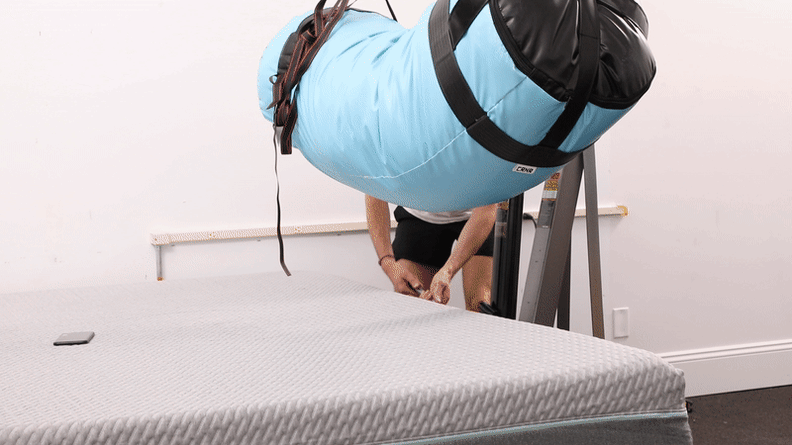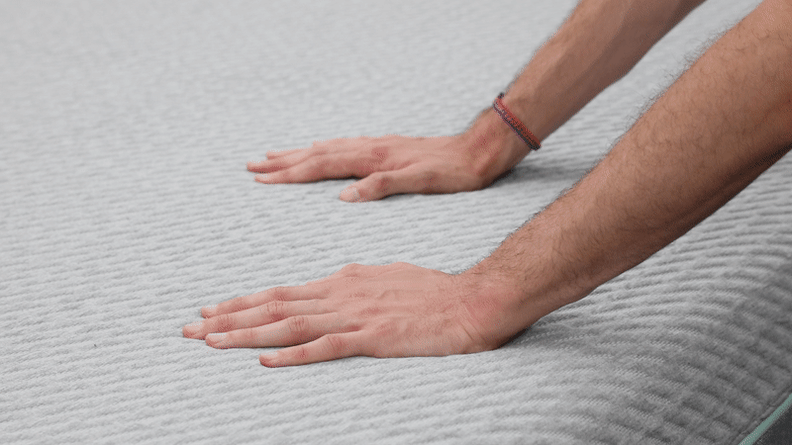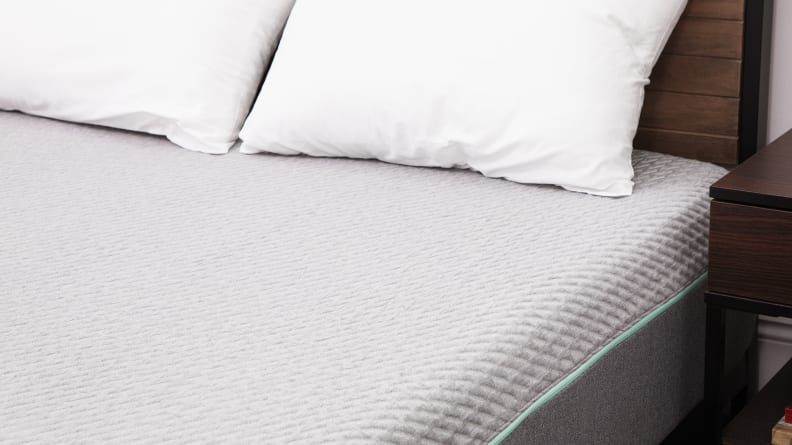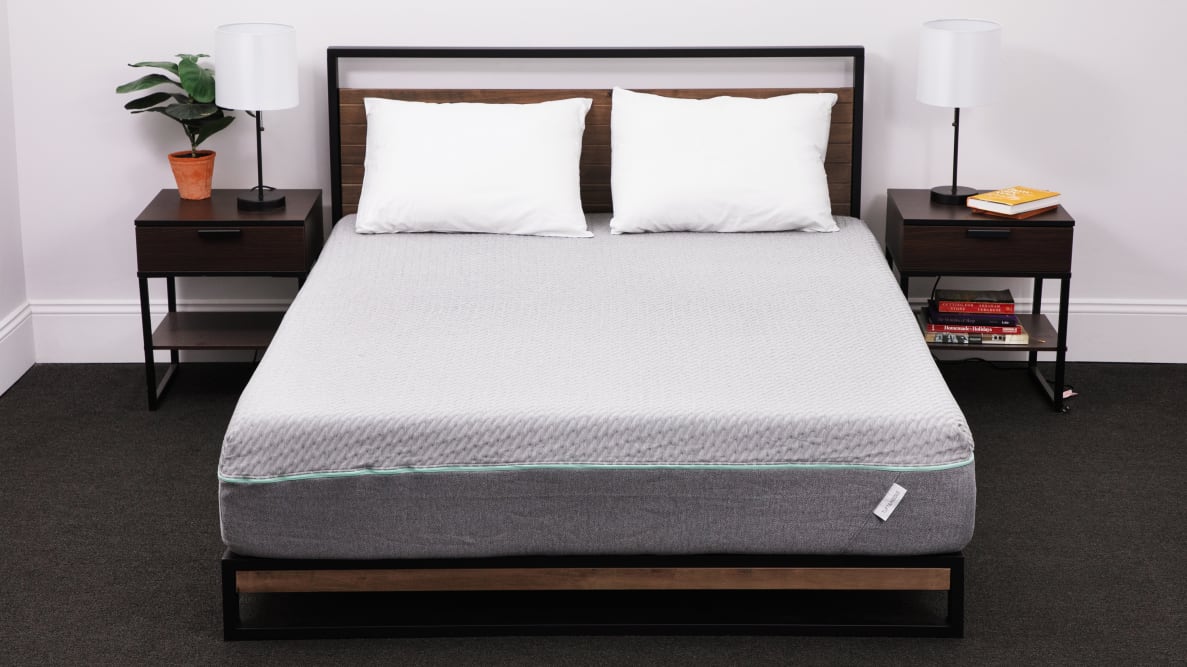Pros
-
Excellent cooling performance
-
Superb edge support
-
Exception support for all sleepers
Cons
-
On the pricey side
What is the Tuft & Needle Mint mattress?

Could this be the new cure to your sleepless nights?
The Tuft & Needle Mint is a foam mattress consisting of multiple layers of material designed to cushion and support sleepers more than a traditional innerspring mattress. The best foam mattresses, especially if they’re made with memory foam, will provide even pressure distribution, allowing the body to sink into the top surface while being supported by the lower layers. They typically tend to be good for side and some stomach sleepers who need the adaptability to comfort joints and pressure centers—if you’ve ever woken up with hip or spine pain, then you probably understand why that adaptability is important. Foam mattresses have their cons, which often includes poor heat diffusion. They also require some sort of support system beneath them, like a platform frame, slatted frame, or a box spring.
Tuft & Needle’s Mint mattress is all foam and has three major layers: a foundational base made of polyurethane, a gel-foam layer designed to diffuse heat, and an open-cell foam top layer, intended to promote air flow through the mattress, and offer a spongy, sink-in texture. This differs from closed-cell foam, a material found in some foam mattresses, which tends to hold in more heat but feel firmer. Tuft & Needle claims their Mint mattress’ open-cell foam is “infused with graphite and cooling gel” to wick heat away from sleepers. The company also says the mattress’ “Mint” foam layer, found just below the surface, contains a cooling gel also designed to promote heat diffusion.
How we tested the Tuft & Needle Mint mattress

Let's see how much this one can handle...
Like any mattresses that our sleep team reviews, we unboxed and tested the Tuft & Needle Mint at our lab in Cambridge, Massachusetts. With the help of Reviewed’s scientists, we ran a number of tests for motion transfer, edge support, pressure relief, and heat diffusion.
We gauge motion transfer by measuring how much energy is detected on one side of the mattress when we drop a 150-pound punching bag onto the other side. This simulates what it would be like to sleep with a tossing-and-turning partner, which Tuft & Needle claims the Mint mattress is specifically designed for. The data helps us determine how the mattress isolates motion across its surface.
For edge-support testing, we measure how much pressure the mattress’ edges can hold up before they give away. This is helpful for understanding more about the actual structure of the mattress. If you like to sit on the edge of the bed or sleep close to it, this test can be important for determining whether you’ll have a firm seat or teeter precariously toward the floor.
We also do a series of pressure-relief tests with various weights, like dumbbells and bowling balls. We use these to simulate the various pressure centers of the body—joints, the spine, and the head—by placing our weights where those centers will be when someone sleeps on a mattress.
Finally, for heat diffusion, we warm some heating pads to typical body temperature and leave them on the mattress overnight. This test involves multiple recordings of the temperature through sheets and blankets, to aim for accuracy as to how people sleep.
What we like about the Tuft & Needle Mint mattress

Instantly ready to be slept on.
Isolates motion well
The Tuft & Needle Mint mattress impressed us with some of the best motion-isolation scores we’ve ever seen. The cushioning surface absorbed movement well, and our data shows that it completely absorbed all of the energy released from dropping the punching bag onto the surface, rather than sending a ripple effect across to the other side. When we tried tossing around on the Mint as a customer would, the mattress continued to isolate our movements.
Indeed, Tuft & Needle claims the Mint was designed and built with two sleepers in mind. Both the top and second layers use a proprietary “T&N Adaptive Foam,” which supposedly contours to the body shape of each sleeper and keeps them supported even if they move around on the surface. While it’s typically a good idea to take how a mattress is marketed with a grain of salt, we found that the data lived up to the brand’s stated expectations.
Diffuses heat
Our scores indicate that the Tuft & Needle Mint does a great job at diffusing heat. In fact, it scored above most of the other foam mattresses we’ve tested, only beaten out by some hybrid mattresses which, with their layers of foam over coils, are known to offer better air circulation. Based on our data, it seems that the Mint absorbs the heat and diffuses it away from the surface effectively, which should keep sleepers on the surface cool throughout the night.
Relieves pressure
The mattress also scored high in our pressure-relief tests. All of our results indicate that the Mint’s surface is able to absorb pressure, especially in the center and middle of the mattress where a person’s spine and hips would be. Likewise, the Mint felt soft but supportive for side sleepers. Just a few minutes spent lying on the mattress suggested that it contoured and cushioned the shape of a person in this sleeping position.
Ready for sleep right away
After unboxing the Tuft & Needle Mint, it immediately expanded to full capacity and was ready for sleeping with no noticeable chemical smell. This surprised us, as some foam mattresses can take days to fully expand and air out, and some manufacturers caution not to sleep on them until this process is complete. Despite stating the Mint is fine to sleep on right away, the instructions say that it needs two weeks of sleeping on to break in.
What we don’t like about the Tuft & Needle Mint mattress
Poor edge support

Memory foam may simply not be for everybody.
After we unboxed the Mint and gave it time to expand, we noticed that you couldn’t put too much pressure on the edges of the mattress or the material would collapse. Tuft & Needle claims the mattress has extra edge support and that “reinforced construction makes it easier to get in and out of bed,” but our tests suggest that the edges are too soft to actually support any weight. Similarly, when we moved the mattress around for testing, we noticed that the Mint barely held its shape. It was floppy and gelatinous, which suggested it may lack some structure.
May be too soft for some
In the same vein, the Tuft & Needle Mint’s surface is quite soft. This could be great for side sleepers, who need the extra contouring to support their sleep position and keep the spine aligned. But for back sleepers and some stomach sleepers, this soft surface could be too forgiving. From just a few minutes getting situated for a nap on the Mint, I felt like I was sinking into the surface and couldn’t shift around easily. Any time I lay on my back, I felt like my body wasn’t aligned with the surface. When I flipped over to my stomach or side, though, the Mint cushioned me almost immediately.
What is Tuft & Needle Mint’s return policy and warranty?
Tuft & Needle offers a 100-night trial, meaning you can return the Mint for a full refund if you’re not satisfied. Shipping and returns are free in the lower 48 states, but customers in Alaska and Hawaii will have to pay return shipping and not be refunded their original shipping cost.
Likewise, any Tuft & Needle mattress is covered by a 10-year warranty, which includes some material defects and production issues. Tuft & Needle lists these defects as a visible indentation or sag greater than ¾ inch in the foam material when no weight is applied to the mattress. The warranty also covers manufacturing defects, physical flaws, issues with the foam materials, or torn fabric covers and stitching.
The limited warranty does not include slight cosmetic flaws, normal wear and tear from everyday use, stains or discoloration, dampness, or individual dislike of the firmness or texture of the mattress.
In the event of a defective mattress, Tuft & Needle will repair or replace the Mint. If the company chooses to replace the mattress, you’ll receive a new model of the same mattress you bought. No repair or replacement will extend or restart the limited warranty.
What other customers say about the Tuft & Needle Mint mattress
The Tuft & Needle Mint mattress has an average score of 4.6 stars out of 5, and a 4.5 out of 5 for both sleep quality and comfort. Reviewers on the company’s website note that the mattress is incredibly comfortable, cool, and soft. One customer writes: “If my house was burning down, and I could only grab one thing, I’d happily die trying to grab the mattress.” Another customer notes that the mattress was the most comfortable they’d ever slept on and easy to set up.
A few reviews note that the Tuft & Needle Mint is not as good of a purchase for back sleepers and noted motion transfer, contrary to our lab test results. One customer wrote, “After reading the reviews, I thought this would be a firm mattress with a plusher top. It’s okay as far as firmness goes, but still feels really squishy overall (not just the top layer) and when others are on the bed, you feel a lot of movement.” The customer went on to not recommend the mattress for a back sleeper and noted that they have to continually flip to other sleeping positions throughout the night.
Is the Tuft & Needle Mint mattress worth it?

A good option for those who are looking to upgrade or just prefer foam mattresses.
Thus far based on our lab tests, we think the Tuft & Needle Mint could be a great option for people who want a cushioning mattress that diffuses heat. Based on customer feedback, it appears that side and some stomach sleepers specifically may appreciate the Mint. It’s a bit on the pricier side of mattresses we’ve tested, but it may be a great upgrade—especially for sleepers who have been wanting a foam mattress that sleeps cool.
Meet the tester
Chris Panella was a staff writer covering sleep, style, and other lifestyle areas. Previous bylines include The Daily Beast, Film Cred, Film Daze, and The Tufts Daily.
Checking our work.
Our team is here to help you buy the best stuff and love what you own. Our writers, editors, and experts obsess over the products we cover to make sure you're confident and satisfied. Have a different opinion about something we recommend? Email us and we'll compare notes.
Shoot us an email




